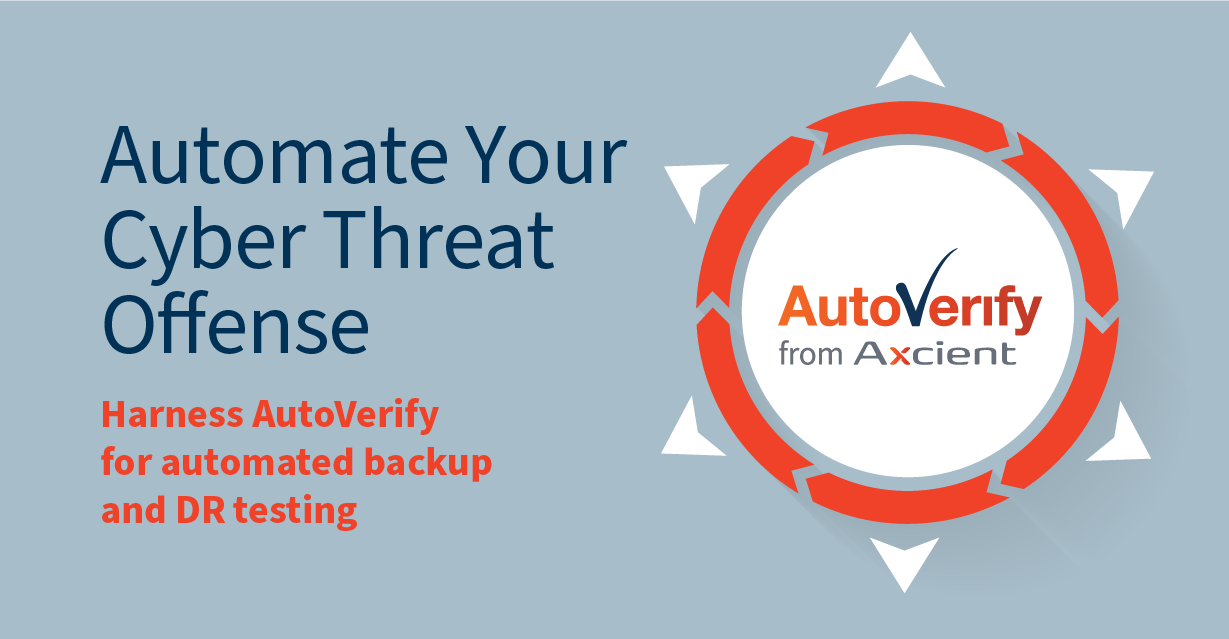
AutoVerify Automated Backup Integrity Testing
Table of Contents
Harness AutoVerify for automated backup testing
Axcient’s AutoVerify technology has been available in our x360Recover business continuity and disaster recovery (BCDR) solution since its inception. AutoVerify is built into both Direct-to-Cloud (D2C) and appliance-based x360Recover to enhance the existing nightly check feature and automate backup integrity verification. As part of our flat-fee pricing, AutoVerify for x360Recover and x360Recover D2C is enabled by default and available at no additional charge to Axcient MSP partners through the x360 Portal.
In this article:
- Gain insights and understanding into what AutoVerify is and how it works.
- Understand the business benefits of leveraging automation over reoccurring manual tasks.
- Find out how to calculate your potential monthly cost savings with x360Recover Direct-to-Cloud and why switching to Axcient isn’t a pain.
What is x360Recover AutoVerify?
As the name implies, AutoVerify is an Axcient feature that automatically verifies the integrity of backups. As part of x360Recover, AutoVerify intelligently tests endpoints on both Axcient vaults and self-hosted private vaults. AutoVerify completes a thorough daily assessment of all drives and data on your protected systems to ensure backups are available and useable. It validates the recoverability of backup snapshots and captures a screenshot of the protected system to give MSPs peace of mind.
AutoVerify immediately alerts, escalates, and even self-heals when backup failures are detected to protect MSPs from the potentially devastating consequences of backup burn.
“The x360Recover solution allows me to ignore it, which is probably one of my favorite things about it. We trust the technology, we know that it works, we know that we have features like AutoVerify that tell us that machines booted after a backup. So being able to know the technology is working without having to keep a thumb on the tech makes it one of my favorite features.” –Mason Feuhrer, Special Operations at Ergos
How Does AutoVerify Work?
AutoVerify is an always-on, included feature with x360Recover and D2C, so no additional payment is needed, configuration requirement, or extra work to worry about. x360Recover supports integration with popular PSA/RMM tools, so AutoVerify data and boot VM screenshots are seamlessly captured and available in the x360 Portal. Additionally, because AutoVerify runs in the cloud instead of on local appliances, MSPs enjoy the same provable recovery expected with traditional backup. Virtualize to the Axcient Cloud or Axcient-hosted vaults or your private cloud vaults with Bring Your Own (BYOC) capabilities. Now that you understand the setup within x360Recover, here’s how it works…
AutoVerify automatically virtualizes the latest backup recovery point for each system and runs numerous deep volume tests to check:
- Bootability
- Operating system health
- Data corruption
- File system and application integrity
AutoVerify testing is segmented into a tiered testing strategy that allows ‘lighter’ tests, like simple boot testing with screen capture, to be performed more frequently than ‘heaver’ tests, such as full volume check disk (CHKDSK) integrity scanning. Testing procedures include:
- Capturing a screenshot of the login page
- Performing heartbeat checks to the testing services running on the VM
- Verifying the functionality of Microsoft Volume Shadowcopy Services (VSS)
- Completing a full CHKDSK scan on all data volumes
With support alerting and escalation rules, MSPs determine when, how, and who is notified of potential issues. So, if everything looks secure, safe, and recoverable, the dashboard of your x360 Portal will prove it for backup confidence, peace of mind, and sleep-filled nights.
“With technology like AutoVerify, we can rest easy knowing that Axcient has built-in protections for our clients’ data. We have confidence in Axcient’s solutions and appreciate that we have a vendor partner going the extra mile to make sure our clients’ businesses are up and running if the worst happens.”
– Paul Charles, CTO at DataTrends
Why is AutoVerify a Better Business Decision for MSPs?
Modern solutions like AutoVerify leverage the power of automation to save us from the repetitive, unnecessary, and labor-intensive (a.k.a. costs) of manually verifying backups. Beyond that obvious benefit, there are five more reasons you should consider AutoVerify as part of your BCDR strategy.
- Proactive alerting prevents critical issue impacts. AutoVerify monitors all key operations with anonymized cloud telemetry to not only provide daily proof of backup recoverability but also to let MSPs know about potential issues before they become critical breaking points to business availability. Armed with unobstructed insights into server production performance, MSPs can confidently carry out incident response plans to guarantee SLAs and ensure BCDR for clients.
- Backup confidence relieves MSP stress. Put an end to ‘backup burn’ so you never have to face the nightmare of trying to restore a supposed ‘successful’ recovery point only to find that some or all of it is unusable. Instead, get proof of backup integrity with the aggregate health status information provided by AutoVerify in-depth testing, reporting, and alerting.
- Direct integration provides an additional layer of security. Other vendors offer solutions they claim will trigger specific tests or workflows, but they are vulnerable to mistakes when the solution is initially configured or a new protected server is added. Because AutoVerify supports direct integration with PSA and RMM tools, intelligent testing is built into x360Recover by default.
- Human error is still the #1 cause of data loss. Avoid the repercussions of the inevitable chance that a manual backup verification is forgotten, an employee leaves unexpectedly, a natural disaster prevents integrity checks, or a disgruntled employee has a lapse in judgment. All of these things happen unexpectedly and more often than you might imagine.
- It costs less and does more. x360Recover is the right choice for MSP profitability. MSPs can automate their backup checks for verifiable failsafe backups without any additional fees – AutoVerify is free to all Axcient partners as part of our flat-fee pricing.
- AutoVerify helps MSPs be compliant and cyber-insured. The backup testing automation with AutoVerify helps MSPs prove they can deliver on SLAs, comply with regulations, and get the best cyber insurance coverage, rates, and payout.
- Free up time. In both cloud and appliance-based deployments, AutoVerify saves labor hours by eliminating the need for daily manual backup checks.
“Whenever AutoVerify says that it will start, it starts. So that’s a huge component from a time-saving point. We’re going to eventually trust it and stop doing the manual verification, which is going to save my guy 20 to 30 hours a quarter… That’s another savings.”
– Phillip Long, Founder and CEO at Business Information Solutions (BIS)
Start Saving Now with x360Recover D2C with AutoVerify
Lower your total cost of ownership (TCO) while increasing data protection security quickly, easily, and without the complications of ‘rip and replace.’ We’ve simplified the process of upgrading your solution with our proprietary Chain-Free backup technology. No hardware means you can silently deploy the Axcient agent through your RMM tools, configure your backup schedule, and start backing up almost instantly – no server reboots required and no need to deactivate existing products. Plus, with Local Cache for D2C, recovery is as fast as it is dependable.
Switching Isn’t Painful with Incremental Vault Recovery
Axcient knows how awful switching solutions can be, so we rolled out Incremental Vault Recovery for a fast, secure, and painless path to migrate to x360Recover. Incremental Vault Recovery is the streamlined deployment method for migrating existing data to x360Recover. Using Incremental Vault Recovery, MSPs can ditch underperforming vendors and expand service offerings without risking loss during the move.
With this new capability, MSPs can use the hardware-free deployment option in x360Recover Direct-to-Cloud to perform a side-by-side deployment of their current backup product. With backups continuing to run safely, MSPs can then cut over to their existing hardware or a new Axcient appliance and backup with x360Recover. By continuing to back up data during the migration and then failing back from D2C to the x360Recover-ready appliance, there’s no rip and replace, missed backups, or lost client data.
Get a Look at AutoVerify
Start Your Free 14-Day Trial Now to see x360Recover and AutoVerify in action. Learn more about Axcient’s One-Two punch for cyber security defense and offense by downloading the no-cost eBook to explore how automation for testing with AutoVerify and Virtual Office will save you time, help you stay compliant, and save a bunch of time.
In this eBook, we’re showing MSPs how to…
- Reduce backup management costs by eliminating one of the most time-consuming tasks required for disaster recovery.
- Demonstrate the value of your services to help grow your client base.
- Be compliant with regulations and more easily meet cyber insurance requirements.
- Take advantage of the latest and greatest features to conserve labor resources, increase productivity, and reinforce disaster recovery readiness.
More Great Stuff From Our Blog:
Check out some other interesting pieces from our blog: MSP-friendly resources and tools to learn how you can ditch pricey on-site appliances with Local Cache for Direct-to-Cloud BCDR., we dove into how chain-based backup works and why chain-free is the way to be, we talked with Jason Phelps from Huntress Labs about planning for the next ransomware attack, and hear our CEO David Bennett explain why the current cybersecurity landscape means traditional backup is dead.
Author
How well could you sleep with reliable cloud-based backups and recovery?
Take a deep dive into Axcient’s proprietary, automated security features to see how we’re ensuring uninterrupted business continuity — no matter what:

